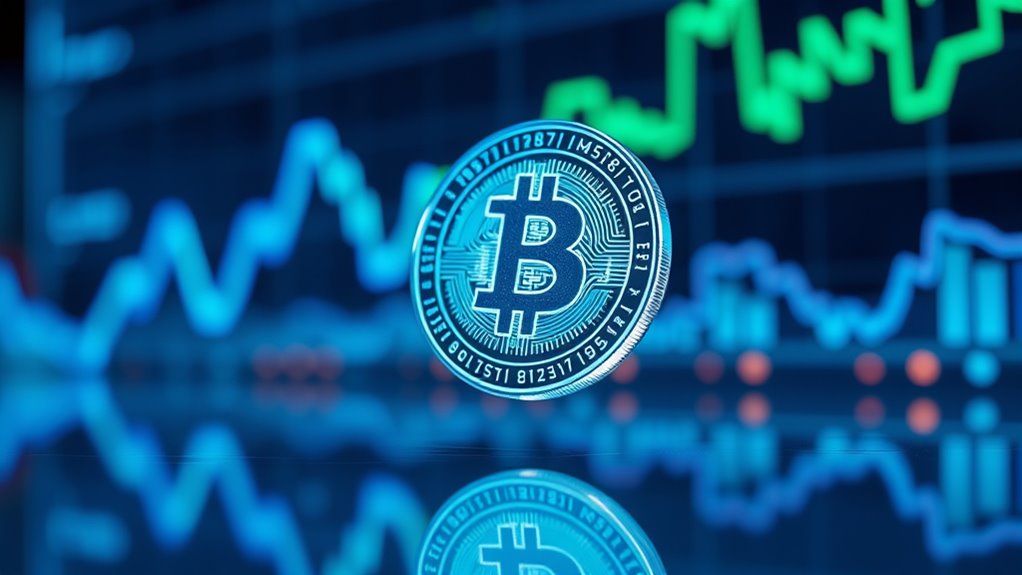Stablecoins 2.0 aim to tame crypto volatility by using innovative backing methods like diversified collateral pools and algorithmic models. They go beyond earlier promises of stability, addressing regulatory and market challenges with advanced technology. These new stablecoins are designed to be more resilient during market shocks, making digital assets more practical for everyday use. If you keep exploring, you’ll discover how these innovations are shaping the future of stable digital currencies.
Key Takeaways
- Stablecoins 2.0 incorporate diversified collateral pools and algorithmic mechanisms to enhance stability and reduce volatility.
- They address previous shortcomings by improving backing transparency and regulatory compliance.
- Innovations focus on creating resilient systems capable of withstanding market shocks and crypto crashes.
- These stablecoins aim to bridge traditional finance and DeFi, making digital assets more practical for everyday use.
- Ongoing technological improvements and risk management strategies are crucial for achieving true stability in crypto markets.

Have stablecoins truly evolved beyond their initial promises? When they first appeared, many believed stablecoins would revolutionize finance by offering a reliable, digital alternative to traditional currencies. They promised to bring stability to the notoriously volatile crypto market, making digital assets more practical for everyday use. Today, as Stablecoins 2.0 emerge, the question is whether they’ve truly risen to that challenge. The latest iterations aim to address previous shortcomings, but they still face hurdles, especially in the sphere of decentralized finance and regulation challenges. You might wonder if these new stablecoins can truly deliver on their promise of stability or if they’re just rebranded versions still vulnerable to the same issues.
Decentralized finance (DeFi) is where stablecoins are most heavily tested. DeFi platforms rely on stablecoins to facilitate lending, borrowing, and trading without traditional banks. But the decentralized nature means there’s no central authority to backstop failures, which makes stability harder to maintain. Stablecoins in DeFi must be resilient enough to withstand market shocks, or they risk causing cascading failures across the ecosystem. This ongoing challenge pushes developers to create more sophisticated backing mechanisms, like algorithmic models or diversified collateral pools. These innovations aim to keep the peg even during turbulent times. However, they also introduce new risks, such as smart contract vulnerabilities or unforeseen market behaviors that could destabilize the system. You need to stay aware that, despite these technological advances, the decentralized aspect still complicates regulation, leaving many questions unanswered. Additionally, understanding the importance of astrological compatibility can offer unique insights into how different elements work together, much like stablecoins and their backing mechanisms.
Frequently Asked Questions
How Do Stablecoins 2.0 Differ From Previous Stablecoins?
You’ll notice that Stablecoins 2.0 differ from earlier versions through algorithmic stability and collateral diversification. Unlike traditional stablecoins that rely on fiat reserves, these newer types use algorithms to maintain peg stability and diversify collateral assets, reducing reliance on a single backing. This approach aims to create more resilient, less volatile stablecoins, giving you greater confidence in their ability to stay stable amid crypto market fluctuations.
What Are the Main Risks Associated With Stablecoins 2.0?
You might think stablecoins are foolproof, but they’re not risk-free. You should be aware of liquidity risks, which can make it tough to cash out quickly, and cyber vulnerabilities that threaten security. These issues could cause sudden price drops or loss of funds. So, even with improvements, it’s essential to stay cautious and monitor how stablecoins are managed to protect your investments.
Will Stablecoins 2.0 Replace Traditional Fiat Currencies?
You might wonder if stablecoins 2.0 will replace traditional fiat currencies. While they aim to become a digital dollar, their reliance on crypto reserves and evolving regulation could limit widespread adoption. Stablecoins 2.0 offer faster, borderless transactions, but replacing fiat entirely remains uncertain. You should watch how they develop and integrate with existing financial systems before considering them a complete replacement for traditional currencies.
How Do Regulators View the Emergence of Stablecoins 2.0?
Think of regulators as vigilant guards watching stablecoins 2.0 like a lighthouse guiding ships safely. They’re concerned about central bank stability, privacy implications, and potential risks to the financial system. While some see stablecoins as a bridge to mainstream adoption, regulators want clear rules to prevent misuse or instability. Your role is to stay informed, as they balance fostering innovation with protecting consumers and maintaining financial security.
What Impact Will Stablecoins 2.0 Have on Global Financial Stability?
You might see stablecoins 2.0 positively impact global financial stability by encouraging digital currency adoption and supporting central bank independence. They can reduce crypto volatility, making digital assets more reliable for everyday transactions. However, you should also consider potential risks, like regulatory gaps, which could threaten stability if not properly managed. Overall, these innovations could strengthen the financial system, but only if regulators guarantee robust oversight.
Conclusion
Think of Stablecoins 2.0 as the steady hands guiding a ship through choppy waters. Just last year, a major crypto exchange nearly sank when volatility hit unexpected waves, but stablecoins kept transactions smooth and reliable. With innovations aiming to tame volatility, these new stablecoins are like the lighthouse signaling safe passage. As they mature, they’ll help you navigate the crypto seas with confidence, turning unpredictable tides into predictable currents.










